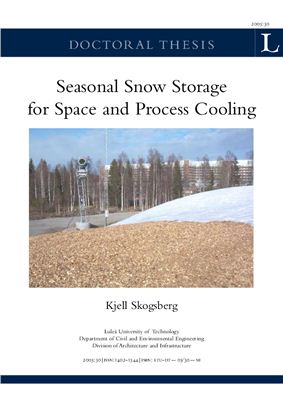На английском языке. Диссертация на соискание ученой степени
доктора наук. Работа выполнена в Luleå University of Technology,
2005, 182 + XIII pp.
Summary
The world’s cooling demand has increased considerably during the last decades due to increased population, industrialisation, comfort demands, electronic equipment usage and new building technologies. Conventional cooling is often produced by electrically driven devices. One less prime energy-consuming alteative is to use stored winter cold in snow and ice for cooling during the summer. This ancient technique is feasible in large parts of the world.
The snow/ice can be stored indoors, on the ground, in the ground and underground. This study focuses on in ground storage, in an open pond, where the cold energy is extracted by water that is cooled by direct contact with the snow. Open pond snow storage must be thermally insulated; hence, different insulation alteatives were discussed. Cutter shavings were studied in laboratory experiments and numerical modelling. The surface melt rate of snow covered with cutter shavings increased with increased solar radiation, air velocity, air temperature, and decreased insulation layer thickness. The surface melt rate was similar with initially wet and initially dry wood chips. The evaporation rate contributed significantly to the energy balance. It was concluded that evaporative cooling is an important part of the thermal insulation qualities of wood chips. It was also found that heat transfer from the rain and ground is usually relatively small.
The Sundsvall Regional Hospital snow cooling plant in Sweden has successfully
operated since 1999. Natural and artificial snow is stored in a slightly sloping, shallow pond of watertight asphalt. During these years, the plant has delivered the main part (77-93%) of the cooling, totalling 655-1,345 MWh. The snow was thermally insulated by a 0.1-0.2 m layer of wood chips. The total coefficient of performance, including construction energy, was 2.0-6.6 times greater than that of a conventional chiller system.
The environmental impact of a snow cooling plant and a chiller system was compared, for both existing and environmentally optimised systems. Of the existing systems, the chillers had the largest impact conceing climate change, acidification and nitrification, while the snow cooling system meant more photochemical ozone emissions. The dominating impact sources of the snow cooling system were fuel and electricity. In the construction phase, ground insulation had the greatest impact. In future open pond storage, a more compact design (deeper storage) is suggested to reduce maintenance and melt loss. Total cooling costs were estimated to be 0.29-0.47 SEK kWh-1 for new open pond storage, i.e. lower than that of district cooling.
The study also comprised the remarkable mass loss that occurs from freezing water. Each freezing means a water loss that corresponds to 2.5-10% of formed ice. This phenomenon was studied since repeated freezing and thawing will evaporate large amounts of water. The freeze loss was estimated to have little effect on the function of snow storage in Swedish conditions, though the loss might be considerable at other locations.
The world’s cooling demand has increased considerably during the last decades due to increased population, industrialisation, comfort demands, electronic equipment usage and new building technologies. Conventional cooling is often produced by electrically driven devices. One less prime energy-consuming alteative is to use stored winter cold in snow and ice for cooling during the summer. This ancient technique is feasible in large parts of the world.
The snow/ice can be stored indoors, on the ground, in the ground and underground. This study focuses on in ground storage, in an open pond, where the cold energy is extracted by water that is cooled by direct contact with the snow. Open pond snow storage must be thermally insulated; hence, different insulation alteatives were discussed. Cutter shavings were studied in laboratory experiments and numerical modelling. The surface melt rate of snow covered with cutter shavings increased with increased solar radiation, air velocity, air temperature, and decreased insulation layer thickness. The surface melt rate was similar with initially wet and initially dry wood chips. The evaporation rate contributed significantly to the energy balance. It was concluded that evaporative cooling is an important part of the thermal insulation qualities of wood chips. It was also found that heat transfer from the rain and ground is usually relatively small.
The Sundsvall Regional Hospital snow cooling plant in Sweden has successfully
operated since 1999. Natural and artificial snow is stored in a slightly sloping, shallow pond of watertight asphalt. During these years, the plant has delivered the main part (77-93%) of the cooling, totalling 655-1,345 MWh. The snow was thermally insulated by a 0.1-0.2 m layer of wood chips. The total coefficient of performance, including construction energy, was 2.0-6.6 times greater than that of a conventional chiller system.
The environmental impact of a snow cooling plant and a chiller system was compared, for both existing and environmentally optimised systems. Of the existing systems, the chillers had the largest impact conceing climate change, acidification and nitrification, while the snow cooling system meant more photochemical ozone emissions. The dominating impact sources of the snow cooling system were fuel and electricity. In the construction phase, ground insulation had the greatest impact. In future open pond storage, a more compact design (deeper storage) is suggested to reduce maintenance and melt loss. Total cooling costs were estimated to be 0.29-0.47 SEK kWh-1 for new open pond storage, i.e. lower than that of district cooling.
The study also comprised the remarkable mass loss that occurs from freezing water. Each freezing means a water loss that corresponds to 2.5-10% of formed ice. This phenomenon was studied since repeated freezing and thawing will evaporate large amounts of water. The freeze loss was estimated to have little effect on the function of snow storage in Swedish conditions, though the loss might be considerable at other locations.

